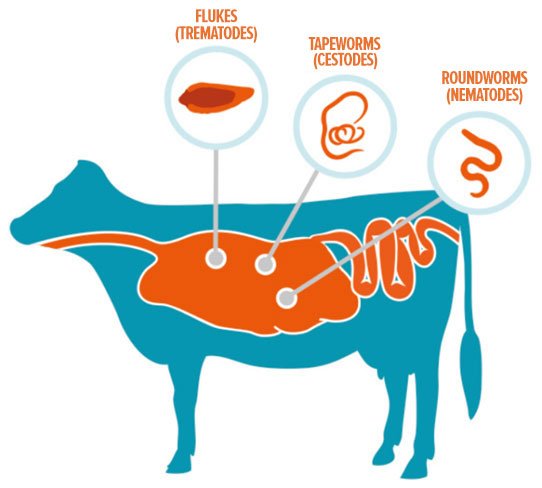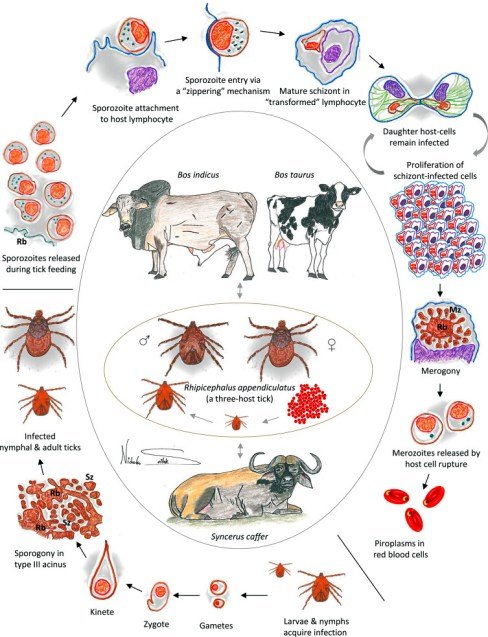Greetings everyone in @stemsocial! I hope you're find. As staunch support of this community, I would like to team up with members here in order to promote the aspect of science and technology. Today, I would like to take you through the interaction of matter and the major changes that are likely to occur. In this broad aspect, we will narrow it down to the parasite infection on animals, types and some control measures.
Let's delve into the concept of parasitism. A parasite is any organism which lives inside or outside of another organism known as Host and derives its nourishment. The parasite benefits by feeding on the host and damage it, but the host in turn doesn't get any benefits from the parasite. Sometimes, the host end up by dying in the hands of the parasites. The parasite releases or injects toxins in the animals which sometimes weakens the host animals. The parasite develop such adaptive mechanism that are able to withstand adverse conditions such as hot sun, cold weather and heavy rainfall.

Types of Parasites
Basically we have 2 types of parasites, depending on the location of places that they live and breed. These are Endo parasites and Ecto parasites.
Endoparasites are parasites which live internally; that's inside the hosts. Examples of internal or endoparasites are flatworms, roundworms and tapeworms. Most of these worms are found in the ileum, lungs, stomach and liver of farm animals or humans. The most observable things we experience is that most of these worms do not stay at one place, but travel round the body cause destruction and wounds to the hosts. Most of the internal parasites suck blood causing severe anaemia to farm animals and and humans, even though others are harmless. For, instance tapeworms are found in the ileum of mammals. Ruminates like goats, cattle and sheep contract them as they graze on their pastures. The eggs can enter into the ruminants liver or intestine and later develop into larvae. The larvae matures and hatches into multiple eggs again. The eggs passes through the ruminates faeces and the cycle continue. The final host like dogs are infested with the worms when they eat the carcass of contaminated slaughtered animal's waste. Human beings easily get them through poor cooking of porks or beef.
It's advisable for proper cooking of meats especially the meat of pigs since they are fond of wallowing in stagnant water and dirty areas of which they can easily be contaminated.
For the life cycle of liver fluke, the larvae is attached to the grasses where the ruminants like cattle and sheep feed. As the animals go on grazing, it eats the grasses with the contaminated liver fluke's larvae. The larvae grow to become matured worms in the ruminants liver and lay multiple eggs. Through droppings, the snail which become carrier of these worms come into contact. After the larvae leaves the snails, the liver flukes remain on the leaves of the grasses. The ruminants are contracted again and the cycle continue. There are others internal parasites like flatworms and long worms that we need to talk about them but we need to leave some space and talk about the Ectoparasites too.
Ectoparasites are parasites which live externally, that's outside the host animals. Examples of Ectoparasites are ticks, lice, fleas, flies, mosquitos, tsetse fly etc. Most of these parasites suck bloods, causes general body itches and loss of hair or wool of animal's body. Most of these ectoparasites like tsetse flies are found in the tropics especially where there are trapanosomia infection. The tsetse fly prefer where there are cattle around. Parasite like ticks are common on dogs and cattle. lice are common on humans.
Some of the loses that the farmer may incur is loss of body weight, economic loss of money and value of the animals, the skin of most animals bodies are used skins so, when the ectoparasites destroy them there would be shortage of leather production. There is a thread to humans around. Most of these parasite can be vectors of other disease and may cause so zoonotic diseases to humans.

Some of the preventive measures are to keep the hygienic conditions of the animals. Pastures can be disinfected for about 1 week before rumination is allowed. Make sure rotation grazing is done to help reduce the breeding grounds of most ectoparasite. Drenching can be done to help prevent the infestation of the internal parasites. The flock of farm animals can be dipped with disinfectants. Make sure to remove all the old litters from the pen and replace with new ones. It's also better to quarantine all external animals, screen first before allowing them to be mixed with your flock of animals. All sick animals should be culled and if any observable signs of I'll health is recorded.
Parasites are very dangerous to both humans and animals. The best ways is to keep good sanitation so that the parasite invasion would be minimal. For instance, the cycle of Internal parasites can be break if we keep proper hygiene and keep the animals in well monitored environment.
Thanks for your contribution to the STEMsocial community. Feel free to join us on discord to get to know the rest of us!
Please consider delegating to the @stemsocial account (85% of the curation rewards are returned).
Thanks for including @stemsocial as a beneficiary, which gives you stronger support.